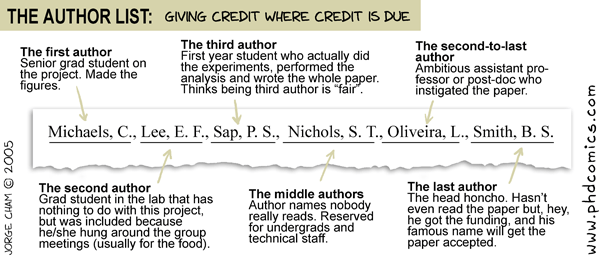When you write a manuscript in any field in academic science, you have to determine who will be an author. (There is also the question of who is the first and corresponding author, but let’s ignore that for now.) Many a collaborative group has been tripped up by disagreements about this. It can be a contentious issue. I have my lab group regularly read and discuss published guidelines for authorship; some examples are here and here. It is also good to discuss up front, when a project is initiated, who will be an author and to continue to talk about it openly. The tricky thing is that roles in a project often change and people often don’t do what they commit to doing.
I recently had a student write me, insisting on being an author on a manuscript she didn’t work on. She sent me a year old email indicating she’d be an author – but she never did what we asked of her, played no role in the analysis or paper writing and only decided to participate once the paper was in review! Sounds crazy I know, but it wasn’t the first time someone failed to understand that you have to actually do something to earn authorship on a manuscript.
Luckily, what you have to do has been precisely outlined by many journals and scientific societies. Here is the criteria we use from the the ICMJE:
An “author” is generally considered to be someone who has made substantive intellectual contributions to a published study, and biomedical authorship continues to have important academic, social, and financial implications (1). An author must take responsibility for at least one component of the work, should be able to identify who is responsible for each other component, and should ideally be confident in their co-authors’ ability and integrity. In the past, readers were rarely provided with information about contributions to studies from persons listed as authors and in Acknowledgments (2). Some journals now request and publish information about the contributions of each person named as having participated in a submitted study, at least for original research. Editors are strongly encouraged to develop and implement a contributorship policy, as well as a policy on identifying who is responsible for the integrity of the work as a whole.
While contributorship and guarantorship policies obviously remove much of the ambiguity surrounding contributions, they leave unresolved the question of the quantity and quality of contribution that qualify for authorship. The ICJME has recommended the following criteria for authorship; these criteria are still appropriate for journals that distinguish authors from other contributors.
• Authorship credit should be based on 1) substantial contributions to conception and design, acquisition of data, or analysis and interpretation of data; 2) drafting the article or revising it critically for important intellectual content; and 3) final approval of the version to be published. Authors should meet conditions 1, 2, and 3.
• Acquisition of funding, collection of data, or general supervision of the research group alone does not constitute authorship.
• All persons designated as authors should qualify for authorship, and all those who qualify should be listed.
These guidelines are essentially the same as those that everyone in science goes by and what is recommended by scientific societies and scholarly journals. In essence, there are three or four (depending on how you break them up) main tasks associated with science and manuscript preparation and you’ve got to have made a meaningful contribution to a majority of them (and preferably all of them) to be an author. You don’t (or shouldn’t) get authorship for just having an idea. I once gave Brian Helmuth an idea that a year later turned up as a science paper. Did I wish I had been invited to work on the project? Sure. Did I deserve authorship just because I had the initial idea? Nope.
Funding or managing or overseeing a project or generally being in charge also does not constitute authorship. Neither does merely helping to collect data as a volunteer or paid technician (that is an intern, not an author or collaborator). Here is what does constitute authorship: (1) initiate, design, and organize a study, (2) collect the data / perform the experiment, (3) analyze and interpret the data, (4) write the manuscript.
Unsure about whether you should be an author on a manuscript? Go through these four steps. If you made a substantial contribution to at least three of them, you probably should be an author. If not, you aren’t. Simple.
Duke – on the rare occasion that Duke scientists actually publish papers – follows a similar guideline: Authorship should be restricted to those individuals who have met each of the following three criteria: 1) made a significant contribution to the conception and design of the project, or the analysis and interpretation of the data, or other substantial scholarly effort; 2) participated in drafting, reviewing and/or revising the work; and 3) approved the final version for publication.
Also see “A graduate students guide to determining authorship” and an associated more complex checklist here. The related authorship contract could also be useful and I like that it explicitly spells out that; It is agreed that authorship order may be renegotiated should an individual’s responsibilities substantially change, or should an individual fail to perform their role as stated above.
PS – Ecology EIC Don Strong, other editors, or really anyone with experience in publishing science; let’s have a conversation! Share your thoughts, experiences, fresh ideas, etc with us. – JB
Update: I just ran across another similar post with the exact same title here. If you’re into academe this is a nice blog.

Leave a Reply